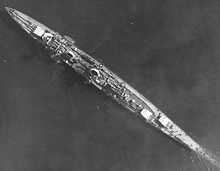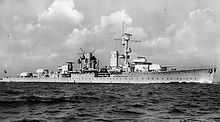German cruiser Karlsruhe
 Karlsruhe at sea in 1931 | |
| Career | |
|---|---|
| Name: | Karlsruhe |
| Namesake: | Karlsruhe, Germany |
| Builder: | Deutsche Werke, Kiel |
| Laid down: | 27 July 1926 |
| Launched: | 20 August 1927 |
| Commissioned: | 6 November 1929 |
| Out of service: | May 1938 |
| Reinstated: | November 1939 |
| Fate: | Damaged by torpedoes fired by HMS Truant and later sunk on 9 April 1940 |
| General characteristics [lower-alpha 1] | |
| Class and type: | Königsberg class |
| Displacement: | 7,700 long tons (7,800 t) |
| Length: | 174 m (571 ft) |
| Beam: | 15.3 m (50 ft) |
| Draft: | 6.28 m (20.6 ft) |
| Propulsion: | 3 shafts, two MAN 10-cylinder diesels, four geared turbines |
| Speed: | 32 knots (59 km/h; 37 mph) |
| Range: | 5,700 nmi (10,600 km; 6,600 mi) at 19 kn (35 km/h; 22 mph) |
| Complement: | 21 officers 493 enlisted men |
| Armament: | 9 × 15 cm SK C/25 guns 2 × 8.8 cm SK L/45 anti-aircraft guns 12 × 50 cm torpedoes 120 mines |
| Armor: | Belt: 50 mm (2.0 in) Deck: 40 mm (1.6 in) Conning tower: 100 mm (3.9 in) |
Karlsruhe was a light cruiser, the second member of the Königsberg class, and was operated between 1929 and April 1940, including service in World War II. She was operated by two German navies, the Reichsmarine and the Kriegsmarine. She had two sister ships, Königsberg and Köln. Karlsruhe was built by the Deutsche Werke shipyard in Kiel; she was laid down in July 1926, launched in August 1927, and commissioned into the Reichsmarine in November 1929. She was armed with a main battery of nine 15 cm SK C/25 guns in three triple turrets and had a top speed of 32 knots (59 km/h; 37 mph).
Like her sisters, Karlsruhe served as a training cruiser for naval cadets throughout the 1930s. During the Spanish Civil War, she joined the non-intervention patrols off the Spanish coast. She was in the process of being modernized at the outbreak of World War II in September 1939, and so she was not ready for action until April 1940, when she participated in Operation Weserübung, the invasion of Norway. She landed troops at Kristiansand, and while returning to Germany, she was attacked by the British submarine HMS Truant; two torpedoes hit the ship and caused significant damage. Unable to return to port, Karlsruhe was scuttled by one of the escorting torpedo boats.
Characteristics

Karlsruhe was 174 meters (571 ft) long overall and had a beam of 15.2 m (50 ft) and a maximum draft of 6.28 m (20.6 ft). She displaced 7,700 long tons (7,800 t) at full combat load. Her propulsion system consisted of four steam turbines and a pair of 10-cylinder four-stroke diesel engines. Steam for the turbines was provided by six Marine-type double-ended oil-fired boilers. The ship's propulsion system provided a top speed of 32 kn (59 km/h; 37 mph) and a range of approximately 5,700 nautical miles (10,600 km; 6,600 mi) at 19 kn (35 km/h; 22 mph). Karlsruhe had a crew of 21 officers and 493 enlisted men.[1]
The ship was armed with nine 15 cm SK C/25 guns mounted in three triple gun turrets. One was located forward, and two were placed in a superfiring pair aft. The rear gun turrets were offset to increase their arc of fire. They were supplied with 1,080 rounds of ammunition, for 120 shells per gun. The ship was also equipped with two 8.8 cm SK L/45 anti-aircraft guns in single mounts; they had 400 rounds of ammunition each. Karlsruhe also carried four triple torpedo tube mounts located amidships; they were supplied with twenty-four 50 cm (20 in) torpedoes. She was also capable of carrying 120 naval mines.[2] The ship was protected by an armored deck that was 40 mm (1.6 in) thick amidships and an armored belt that was 50 mm (2.0 in) thick. The conning tower had 100 mm (3.9 in) thick sides.[3]
Service history

The new cruiser was ordered as "Cruiser C" and given the temporary name Ersatz Medusa as a replacement for the old cruiser Medusa.[3] Construction of Karlsruhe began on 27 July 1926 with her keel laying at the Deutsche Werke shipyard in Kiel. She was launched on 20 August 1927, and she was commissioned into the Reichsmarine on 6 November 1929.[4] Karlsruhe completed sea trials in the Baltic Sea after entering service, after which she was assigned to training ship duty. In May 1930, she departed on her first overseas training cruise, to Africa and South America. After returning to Germany, she was modernized late in the year; her foremast was shortened, and her rear superstructure was slightly enlarged. Over the next five years, she embarked on four more world cruises for naval cadets, traveling as far as Japan. Between each cruise, she conducted exercises with the rest of the fleet in German waters. Günther Lütjens served as the ship's commander from September 1934 to September 1935.[5] In 1935, she had more modifications made, including the installation of a pole mast aft of the funnels, along with an aircraft catapult amidships with a crane to handle floatplanes.[6]
On her last training cruise in 1936, Karlsruhe was badly damaged by a tropical storm in the Pacific Ocean.[7] Structural weaknesses in her mostly-welded hull plating caused significant damage, and the cruiser was forced to put in to San Diego in April for repairs. There, her hull was repaired and strengthened, which increased her displacement and beam slightly.[4] She returned to Germany in June 1936, and immediately went into drydock for more permanent repairs and a major overhaul. During this period in dockyard hands, she had her two single-mount 8.8 cm anti-aircraft guns replaced with three twin-mounts. Fire control directors were also installed for these guns. After emerging from this refit, she conducted sea trials and then joined the non-intervention patrols during the Spanish Civil War, though she only remained off Spain for a few months.[5]
World War II
After returning to Germany, she resumed training duties in the Baltic. She was withdrawn from service in May 1938 for a major modernization. The funnels were modified with raked caps and searchlight platforms on their sides. The ship's 8.8 cm guns were replaced with more powerful 10.5 cm guns. Work lasted until November 1939, shortly after the outbreak of World War II. She spent the next several months on trials and training maneuvers.[7] On 4 January, Karlsruhe and the minelayer Schiff 23 were sent to intercept the Swedish steamer Konung Oscar, which was transporting Polish refugees from Riga to Sweden. Karlsruhe caught the Swedish vessel, declared it a prize, and sent it and the 41 Poles aboard to Memel.[8] She was not ready for combat operations by the start of Operation Weserübung, so she was used as a troop transport for the attack on Kristiansand.[7] The attack force also included an E-boat tender, four large torpedo boats, and several E-boats.[5]
The invasion force left Bremerhaven early on 8 April 1940, bound for Kristiansand. When they arrived, a heavy fog obscured the city, making the passage of the fjord outside the harbor very dangerous. As a result, they had to wait until the following morning to begin the attack. As Karlsruhe entered the fjord, she came under heavy fire from the Norwegian coastal guns. The cruiser turned in the fjord to bring her full broadside into action; the artillery duel lasted for about two hours before heavy fog again covered the port, forcing both sides to cease fire. The Norwegians surrendered an hour later, and the German ships landed their soldiers.[9]
Karlsruhe then left Kristiansand with three of the torpedo boats as escorts. The British submarine HMS Truant was positioned outside the fjord, and when her crew spotted the German ships, she fired a spread of torpedoes.[9] Karlsruhe zig-zagged to evade the torpedoes, but two still hit the ship; one struck her bow and the other hit amidships. They blasted large holes in the hull and allowed thousands of tons of water to flood the ship. The flooding disabled her engines and electricity generators, which cut off power to the pumps that were trying to keep pace with the progressively worsening flooding. With the pumps shut off, there was no hope to save Karlsruhe, and so her commander, Friedrich Rieve issued the order to abandon her two hours after the attack. The torpedo boat Greif took off her crew and fired two more torpedoes into the ship to ensure that she sank.[4][10]
Rieve and his executive officer were both severely criticized for failing to take all possible steps to save Karlsruhe in a later investigation into the sinking. The report concluded that since the ship was still afloat after two hours, and two torpedoes were required to sink her, it might have been possible to take her under tow back to Kristiansand or another port. In addition, the forward pumps still had power, and so the flooding could have been slowed enough to permit a return to a safe harbor.[10]
Notes
| Wikimedia Commons has media related to Karlsruhe (ship, 1927). |
Footnotes
- ↑ These statistics are for the ship as completed; over the course of her career, armament, crew size, and other characteristics of the ship changed.
Citations
References
- Gardiner, Robert; Chesneau, Roger (1980). Conway's All the World's Fighting Ships, 1922–1946. Annapolis, MD: Naval Institute Press. ISBN 0870219138.
- Gröner, Erich (1990). German Warships: 1815–1945. Annapolis, MD: Naval Institute Press. ISBN 0-87021-790-9.
- Rohwer, Jürgen (2005). Chronology of the War at Sea 1939–1945: The Naval History of World War Two (Third Revised ed.). Annapolis, Maryland: Naval Institute Press. ISBN 1-59114-119-2.
- Williamson, Gordon (2003). German Light Cruisers 1939–1945. Oxford, UK: Osprey Publishing. ISBN 1-84176-503-1.
| ||||||||||||||
Coordinates: 58°04′N 8°04′E / 58.067°N 8.067°E